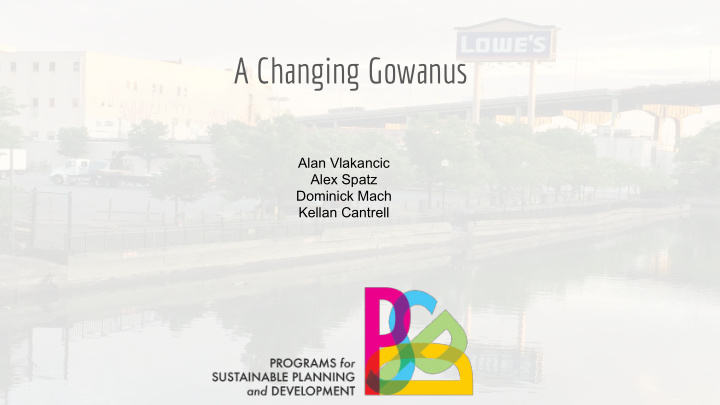



A Changing Gowanus Alan Vlakancic Alex Spatz Dominick Mach Kellan Cantrell
Study Area in Context
Historical Significance In 1886 the site is occupied ● by the Metropolitan Gas Light Company 1904 the site is used as a ● storage facility for the Metropolitan Works Branch
A view of the 9th street bridge from the site Photos dated early 1900’s
Existing Conditions - Current zoning for primarily industrial focuses - M1-2 for manufacturing uses - Apparent brownfield - Pollutants below the Lowe’s complex - Contaminant runoff - Combined Sewer Overflow - Potentially in need of remediation - Located within Census Tract 0117 - 2,364 Population (2010 Census) - 20.9% (493 total) under the age of 18 - 15.2% population decrease since 2000 Census - Despite city- state- and nation-wide population increase - Area in need of reinvigorating and reactivation
SWOT Analysis Strengths Weaknesses - Ample land to work with - Contaminants - Vacant land for flexible uses - Currently limited array of animal - Access to water species - Salvage yard - Relatively abandoned and inactive region Opportunities Threats - Central location within the - Pollution from Hamilton Avenue neighborhood traffic - Ability to reach and serve diverse - Population decline group of actors
Site Goals - Connecting the surrounding neighborhoods to the Gowanus - Establishing connectivity between fractured areas (commercial, industrial and residential) - Provide green space and an access space to the water edge’s - Improving the water quality in the gowanus - An increase of green infrastructure for both environmental and educational goals - Stormwater capture - Providing education about Brooklyn’s industrial heritage and the balance between industry, residents and wildlife - Depict the change in gowanus - Restore the presence of forgotten species - Balance invasive vs. non-invasive
Existing Conditions TO 9th St. TO 2nd Ave PARKING LOT GOWANUS CANAL LOWE’S EX-PATHMARK TO 12th ST.
bike+ped Proposal automobile access access SALVAGE to 9th St. to 9th St. YARD Solar Prairie Spectrum Runnels leading to different types of stormwater capture Sensors to monitor which Constructed method is best Wetland Bike & Ped Path LOWE’S Kayak launch Roof access & Connector gathering area Field Station bike+ped bike+ped automobile Green facade access access to access Roof garden exhibiting to 12th St. 12th St. to 12th St. the interplay between native and non-native species
Section Focus View from across the Gowanus Solar Prairie Field Station Roof Garden Spectrum Green Facade Constructed Connector Wetland
Section Focus 12th Street Section Roof Garden Green Facade LOWE’S Bike+Ped +Automobile Parkland access Bike+Ped access
Assets Field Station Passive: Operation of natural species in an industrial environment - how do they adapt? - do they adapt? - Invasive plant pros and cons - Native plant pros and cons Active: Teaching how ‘things change’ and how human actions can cause this change - Documentation of departing species - documentation of species returning - Migratory birds & species
Assets Invasive vs. Native Roof Garden - Create a walkable green environment that features: - Roof garden - Introduction of new plant and wildlife species - Vegetable, fruits, flowers, birds, butterflies - Solar panels for energy absorption and redistribution - Green surfaces for water absorption - Observation deck field station - Case Studies and Prior Precedents - Burnley Living Roof; Melbourn, Australia - http://www.hassellstudio.com/en/cms-projects/detail/burnley-living-roofs/ - Gary Comer Youth Center Green Roof; Chicago, IL - https://lafoundation.org/myos/my-uploads/2011/10/05/garycomermethodology.pdf
Assets Establishing connectivity - Highlight accessibility by making the lot a central transportation point where neighborhood residents can meet, observe, learn, and relax - Appeal to residents of all capacities...far and near, local and external, low and high income - F and G stops at Smith Street Station - Bike and running trail - Kayak and canoe dock along the canal - Automobile access through the Lowe’s parking lot - Gowanus Canal sign on Pathmark wall can serve as a welcoming sign to increase site visibility and attract residents from all over - Link and unify all neighborhood actors - The built environment with the natural environment - The road with the canal - Recreational uses with educational uses - All of the different populations within the neighborhood both with each other and with the various other species that inhabit this site.
Assets Green Infrastructure Runnels A series of runnels that filter water with a variety of green infrastructure methods, to determine which is best. Provides an educational and interactivity benefits. Shrubbery & Water filtering plants Mulch Retention Soil Water inlet Gravel Water Infiltration Regular Soil The runnels will end in interesting sensors that are designed by local artists, to promote the noticeability and interaction with the users
Assets Solar Prairie
Assets How does it “feel” - Connected - Green, natural but functional to the space - Accessible for all - Easy space to just pass through on a bike or to stay for a few hours - Park hardware created using local businesses. (Reclaimed metal from metal recycling plant or from the surrounding salvage yards) - Highlighting the access to the water’s edge without losing the connection of the urban environment
Water Use System Diagram Water enters site Runnel Runnel Runnel Bioswale Bioretention cell Constructed Wetland
Moving Forward - Metric Measurements Needed - Measuring the return of natural habitats - Stormwater capture from - Toxicity of the water at different levels - Which system is better - Measure energy capture - Interim park in abandoned Pathmark building - Research microhabitats for Solar Prairies
Thank You! Questions?
Recommend
More recommend